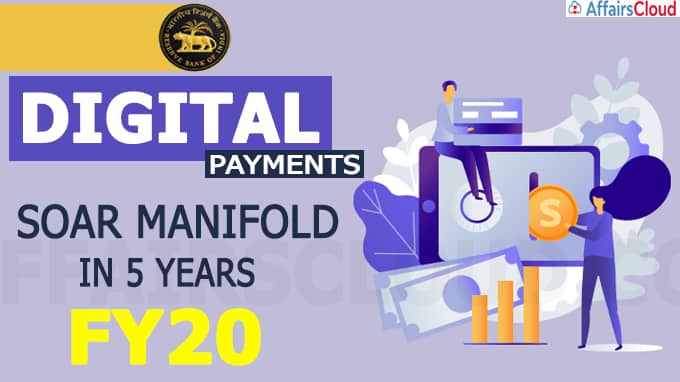
- In absolute terms, this value has grown from Rs 920.38 lakh crore to Rs 1,623.05 lakh crore during this period at an annual compounded rate of 15.2%.
- As percent of card usage, they are being used increasingly for payments–from 20 per cent in FY16 to 45 per cent in FY20, with debit card turnover outpacing credit card values.
Following table showing Year-On-Year rise in Digital Transactions:
| Year | Digital Payments | Value |
|---|---|---|
| 2015-16 | 593.61 crore | Rs 920.38 lakh crore |
| 2016-17 | 969.12 crore | Rs 1,120.99 lakh crore |
| 2017-18 | 1,459.01 crore | Rs 1,369.86 lakh crore |
| 2018-19 | 2,343.40 crore | Rs 1,638.52 lakh crore |
| 2019-20 | 3,434.56 crore | Rs 1,623.05 lakh crore |
It should be noted that in FY20 digital payments saw a massive increase in volumes in comparison to FY19 but in value it slipped down to Rs 1,623.05 lakh crore, due to steep fall in the overall economy forcing people to spend less and save more cash.
What factors pushed digital payments?
-Initiation of National Electronic Fund Transfer (NEFT), Real Time Gross Settlement (RTGS) and Electronic Clearing System (ECS) payments.
-Demonetisation (Note Ban) of all Rs 500 and Rs 1,000 banknotes in November 2016.
-Development of Unified Payments Interface (UPI) based payments as well as app-based payments.
-Promoting a safe, secure, sound and efficient payment system by RBI viz. mandating use of only EMV (Europay, Mastercard, and Visa) chip and PIN-based debit and credit cards from January 2019; tokenization from January 2019, facility to switch on/off transaction rights, among others.
RBI to Adopt NGTA for Managing Forex, Gold Reserves
RBI has decided to adopt Next Generation Treasury Application (NGTA) for managing India’s foreign exchange and gold reserves in order to improve its functioning. In this regard, RBI has invited bids from eligible vendors. The prime bidder should have a minimum annual turnover of at least Rs 475 crore 2017-18, 2018-19 and 2019-20.
What is Next Generation Treasury Application (NGTA)?
It is a web-based application providing scalability, maneuverability and flexibility to introduce new products and securities, besides supporting multi-currency transactions and settlements like Fixed Income (FI), Forex (FX), Money Market (MM) and Gold.
- It can automatically fetch all the relevant details of a security/contract from a trading platform.
- Apart from this it will also help in portfolio management, workforce management, repository management and integration with various third party systems.
Points to be noted:
–India’s foreign exchange reserves rose by USD 3.618 billion to reach a life-time high of USD 545.638 billion in the week ended October 2, 2020.
–The gold reserves were also up by USD 486 million in the same week to USD 36.486 billion.
–The special drawing rights with the International Monetary Fund (IMF) rose by USD 4 million to USD 1.476 billion and reserve position with the IMF was also up by USD 23 million to USD 4.631 billion in the same week.
Recent Related News:
i.On September 2, 2020, Small Industries Development Bank of India (SIDBI) has inked a Memorandum of Understanding (MoU) with the Government of Maharashtra to develop the micro, small and medium enterprise (MSME) ecosystem in the state.
ii.On September 15, 2020, RBI issued Draft Rupee Interest Rate Derivatives (Reserve Bank) Directions, 2020 under Section 45 W of the RBI Act, 1934 to allow foreign portfolio investors (FPIs) to undertake exchange-traded rupee interest rate derivatives transactions subject to an overall ceiling of Rs 5,000 crore.
Static points about Reserve Bank of India (RBI):
-It was established on the recommendation of the Hilton Young Commission.
-RBI is responsible only for printing the currency notes. Minting of coins is done by the Government of India.
-Dr. Manmohan Singh is the only Prime Minister to have also served as the Governor of RBI.